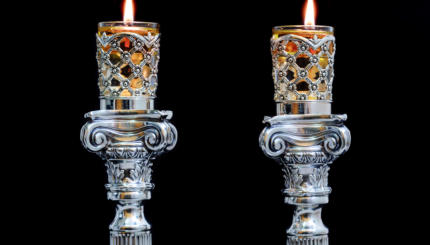A midrash that appears a number of times in the mystical work known as the Zohar describes seven weeks of purification culminating in the union of all worlds–a holy marriage–consummated on Shavuot. The following article explores this mystical imagery as well as other connections among female symbolism, the counting of the omer, and Shavuot.
As a biblical festival, Shavuot marks an agriculturally based economy moving from the barley to wheat harvest. Rabbinic interpretation of Exodus 19:1–which announces the arrival of the children of Israel in the Sinai desert in the third month after going out of Egypt–establishes the primary liturgical function of Shavuot as a celebration of God’s giving of the Torah to the Jewish people.
By the medieval period, biblical narrative and law become fertile sources for kabbalistic (mystical) understandings of the nature of this reception of divine law, most particularly the feminine aspect of the counting of the days between Passover and Shavuot, or sefirat ha-omer. Each of the 49 days of the counting of the omer emerges not as part of a grid linking a shift in communal Temple practice, but as a metaphor for an incremental cycle moving toward unification of the male and female aspects in the godhead.
Divine Wedding
In the Zohar I:8a, the metaphor of mystical union finds expression in the beloved kabbalistic image of the divine wedding. Immersed in Torah at an all-night study session on the evening of Shavuot, students of Torah serve as the retinue for the bride, Shekhinah (the female aspect of the godhead Malkhut), as she prepares to meet her male counterpart, Tiferet. Likely the origin of the now widely observed custom of Tikkun Leyl Shavuot (staying up all night to learn Torah on the first night of the festival), the Zohar’s vision of ecstatic Torah study consummating the fusion of male and female divine energy marks the crest of the counting of the omer. Unification of the Shekhinah with its male counterpart via Torah study of mystical intent is particularly apt on Shavuot, a festival rooted in Temple sacrifice, because the female presence of the divine is often depicted as having a unique attachment to the Temple because, according to tradition, it sojourned only in the Temple
Descriptions of the connection between Temple sacrifice and kabbalistic models of divine union with sexual connotations appear throughout the Jewish canon. Rabbi Yehudah Leib Alter of Ger–a 19thand early 20th century Hasidic master known as the Sefat Emet or the Language of Truth–explores this interpretive track by linking biblical commands for Temple offering–korbanot–to striving for ecstatic unity with the Divine–hitkarvut (Sefat Emet 3:3). [Both these Hebrew words share a common root consisting of the Hebrew letters kuf-resh-bet thus strengthening the connection between the biblical commands.] The template of 49 days of the omer–seven days multiplied by seven weeks–parallels the traditional Jewish family purity cycle requiring women to count seven days of menstruation followed by seven “clean” days before commencing intercourse with their partners. Both “seven times seven” of a human couple and sefirat ha-omer of the divine duality culminate in sexual union, each turning a very public ritual Temple act into one of greatest intimacy, individuality, and privacy. This parallel expresses the transformation of korban (sacrifice) to hitkarvut (unity) at its most visceral.
The Book of Ruth
The Book of Ruth, a narrative interwoven with both the practice and interpretation of Shavuot since the rabbinic period, deepens the relationship between feminine purity in the preparatory stage of the omer, reception and continuation of the Jewish national covenant, and earlier biblical manifestations of agricultural transition. Because it takes place during the shift from barley harvest to wheat (Ruth 2:23) in the chaotic days “when the judges rule” (Ruth 1:1), the narrative engages the same transitional moment as Shavuot. A nation moves from one staple crop to another, and, most importantly, from a form of tribal lawlessness towards kingship. In historical terms, The Book of Ruth offers the narrative link that allows for the Davidic line to persist, Ruth having descended from Peretz, one of the children of Yehudahh, and she and Boaz being the great-grandparents of David’s father Jesse.
The character of Ruth, like the kabbalistic interpretation of sefirat ha-omer itself, embodies female emergence from impurity to purity. Ruth is a female descendant of Tamar, a figure symbolic of a reoccurring biblical motif of a woman (or man, described with distinctly feminine characteristics such as Joseph) charged with fulfilling Israelite destiny despite corrupting male challenges to her personhood. Deceived by Yehudah and disallowed her rightful opportunity to marry her husband’s surviving brother, Tamar must resort to deception, dressing as a prostitute, sleeping with Yehudah himself, and conceiving twins, one of whom is Ruth’s forebear Peretz.
Tamar’s story is of a woman and her needs hidden, either ignored or unseen by the men who can redeem her. The sexual encounter of Yehudah and Tamar takes place at Petach Eynayim (Genesis 38: 14)–literally the Opening of Eyes–where she is forced by her male partner into a deceptive act bordering on impure due to his resistance and “closed eyes” to a feminine need for procreation that transcends sex. Unlike Yehudah, Boaz–literally translated from Hebrew as “in him is strength”–sees Ruth as unique and indispensable immediately, asking directly, “Whose maiden is this?” (Ruth 2:5) at their first meeting. He recognizes Ruth and assures her sustenance, allows for legal and public assessment of her marital status, and redeems her and ultimately all of Israel from a state of spiritual and historical limbo.
While the projection of female impurity, sexual union, and the holy feminine form redeemed only by the male seer results from both religious genius and male-dominated fantasy, the juxtaposition of the feminine aspect with sefirat ha-omer still offers a profound reading of the Jewish festival cycle. The Jewish people, in the role of a spiritually unredeemed woman much like Tamar or Ruth, emerge from Passover, a celebration of freedom profaned by the taint of death. The Israelites crossing the Red Sea are free but still impure with the blood of the dead Egyptian first born and the blood of the lambs marking every Israelite door. Forty-nine days in the desert replicating the “seven and seven” cycle ritualizing a woman’s menstruation prepares Israel for their ecstatic encounter with Torah. The cycle of emergence from impurity to purity, wantonness to commitment, and spiritual desert to divine unity is to be relived in every liturgical calendar year.
Hasidic
Pronounced: khah-SID-ik, Origin: Hebrew, a stream within ultra-Orthodox Judaism that grew out of an 18th-century mystical revival movement.
Midrash
Pronounced: MIDD-rash, Origin: Hebrew, the process of interpretation by which the rabbis filled in “gaps” found in the Torah.
Shavuot
Pronounced: shah-voo-OTE (oo as in boot), also shah-VOO-us, Origin: Hebrew, the holiday celebrating the giving of the Torah at Mount Sinai, falls in the Hebrew month Sivan, which usually coincides with May or June.
Torah
Pronunced: TORE-uh, Origin: Hebrew, the Five Books of Moses.
Zohar
Pronounced: ZOE-har, Origin: Aramaic, a Torah commentary and foundational text of Jewish mysticism.


